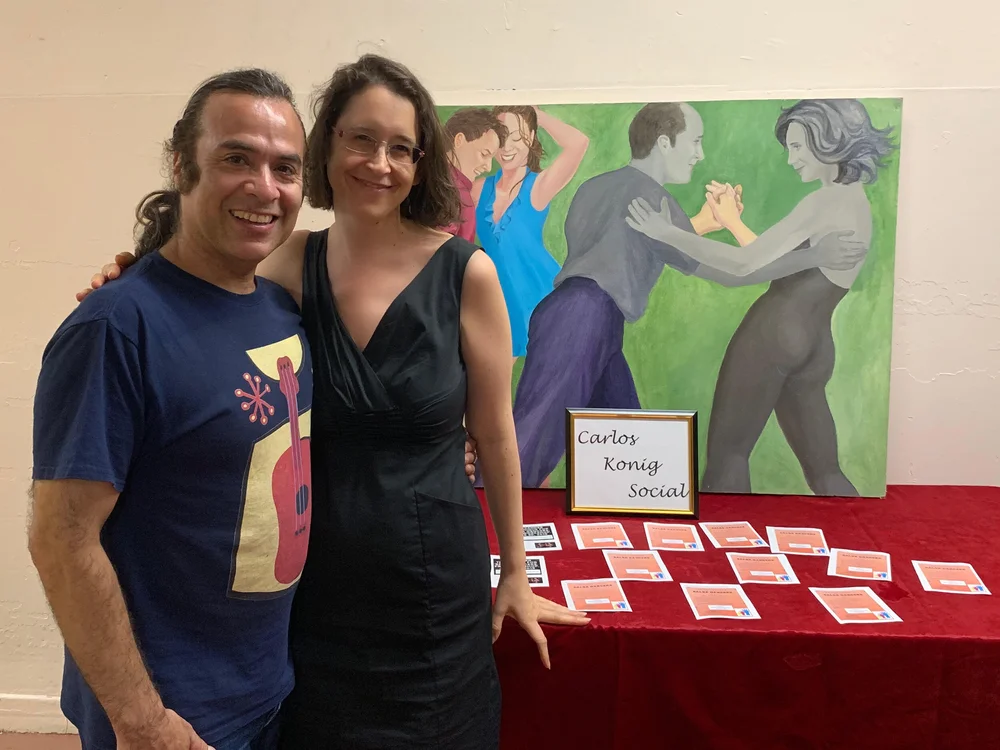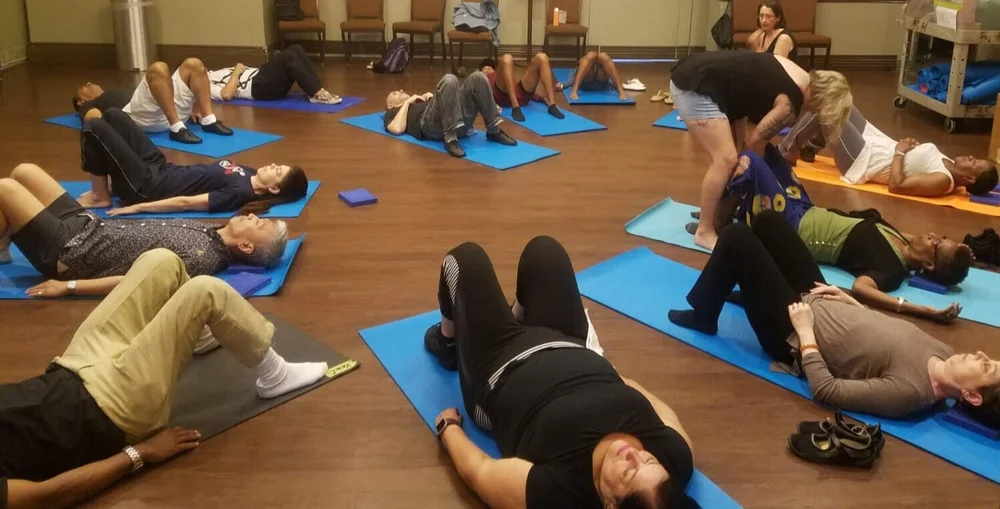Allowing oppositional forces in the body, can help us reduce tension and execute dance moves more fluidly when dancing on your own or with a partner.

Applying new ideas to turn patterns at the workshop.
Check out the exercise to try on your own below!
On June 30, 2019, I led a workshop for New York City dancers as part of the 2019 Annual Conference of the American Society for the Alexander Technique (AmSAT). This helped me share the benefits of the Alexander Technique my salsa community and also share the energy of the vibrant NYC Salsa community with my Alexander Technique community.
Inspired by the benefits salsa dancers found at this workshop, Heather Dunnee and I will be developing a virtual workshop for salsa dancers. Salsa dancers at this workshop shared that the explorations gave them a sense of empowerment — they left with new options to explore on the dance floor including:
paying attention to the support of the floor
focusing on the space within themselves; and
matching the pressure from dance partners when leading or following.

Passing out flyers to promote the workshop at the Carlos Konig Salsa Social, one of my favorite places to dance!
Read about what inspired me to teach this workshop here, including what the Alexander Technique has meant to my salsa dancing.
Here is taste of what we explored in the class and a few activities to try on your own:
We livened up our bodies and connected with other dancers, filling the 3rd Floor of the Columbia University Faculty House with salsa music from popular artists originating from across the world like Hector Lavoe (Puerto Rican), Celia Cruz (Cuban), and Africando (featuring New York-based salsa musicians with Sengalese vocalists).

I led explorations around oppositional force with a focus on gravity ass well as what happens when our hands meet in partner dancing.
The earth’s gravitational field keeps us grounded and, if we allow it, it’s counterforce keeps us buoyant. Thus, the forces of gravity travel both down and up along our bodies.
Our bodies connective tissues create a dynamic network that distributes gravity’s forces into every inch and every cell of the body. Inside our bodies, bones create space and tissues like fascia, tendons, ligaments and out skin create compressive forces in the system. Thus, within the body, there are expansive and compressive forces that counter each other when the systems is working well.
When we come into contact with something, like each other’s hands in the exercise below, there is an opportunity to sense forces into and away from the points of contact.
Becoming more aware of these oppositional forces can help us let go of habits of using extra muscular effort we may be using to keep ourselves upright and move ourselves around. When we use only the muscle tone needed for an activity, the body can operate most efficiently helping us to meet our goals on the dance floor and off.

Deepening partner work at the workshop.
We danced again, exploring how being aware of how the support of the ground and other oppositional forces took shape with different partners.

Ending the workshop with a self-care practice that can be used before or after dancing to enhance body alignment and release tension. Alexander Technique teachers Heather Dunnee and Allyna Steinberg circulate to those that wanted hands on work to re-enforce body awareness, alignment and relaxation.
We also explored a “lie down”, which I sometimes call the 5-minute un(fix), which can be used to release tension a night of dancing.
Here is the activity to try on your own:
Put on a salsa tune and dance for a few minutes
Pause the music and notice the energy in your body and bring your attention to the support from the floor; remind yourself:
I am supported by the earth, its gravitational field keeps me grounded and, if I allow it, its counterforce keeps me buoyant.
I do not have to hold myself up.
Every inch and every cell of my body is held in oppositional forces: my toes and heels, ankles, legs, pelvis, stomach, lungs and rib cage, shoulders, arms, wrists and fingertips, spine and head, and everywhere in between.
The forces of gravity travel down and up along my body, arms, and spine.
Next, look at something to your left or right or behind you, and walk towards it and back while noticing the dynamic support from gravity before each step.
If you feel it was harder to walk and notice the support of gravity, try the 5-minute un(fix) before going on to the next step.
Put on your salsa tune again, and start dancing noticing the support of gravity; repeat to yourself some of the reminders above.
What do you notice in your dancing? If this is juicy, please leave a comment and tell us about it! There is a chance you noticed that you lost your awareness of the dynamic support of gravity from the floor, when you dance. If this happened, don’t despair. In fact: First, REJOICE because noticing this is likely new and means you’ve already made a change. Second, try repeating steps 1-3 playing with different walking speeds with the music off and then on before starting your salsa basic. This will help you practice using your attention differently and allowing the support from gravity as you change your movement with different speeds, with music, and finally with dance steps.
Next, if you would like to explore how this relates to your lead or follow, try this:
Can you put a hand on the wall while maintaining awareness of the dynamic support from gravity?
If you lose your awareness of the floor as you move your hand(s) to the wall or as your hand(s) come to contact with the wall:
Pause right before your hand comes into movement or contact to pay attention and invite the dynamic support of gravity up and down your body and spine, and
Start moving your hand from your fingertips (not the pads of your fingers but the very ends of your fingers above your fingernails (or just inside your fingernails if you have long nails). This gets your awareness all the way to the edges of your body which allows your body to work as a whole as it’s designed.
Once you master placing one hand on the wall with your sense of support from the floor, explore maintaining your awareness of the dynamic support of gravity while making contact with two hands at the wall, then opening and closing a door, opening and closing a drawer, picking up different objects and turning them or turning yourself while in contact with them. Then, find a partner interested in exploring this and try the following palm-to-palm before getting into full dance formation and trying patterns:
Invite each other to notice the support of gravity before your hands come to touch; repeat the reminders in the first exercise (I am supported by the earth….).
Once palm-to-palm, explore different amounts of pressure between your palms (what happens if you provide a lighter touch? a deeper touch?) and how that relates to your awareness of the support of gravity. Also, dialogue with each other about what feels like the right amount of pressure or connection.
Once you have a connection that also allows you to sense the support of the floor, switch off playing the role of leader and follower in a simple movement, like moving each other forward and back. Keep coming back to your awareness of the support of gravity, and introduce more complex movements as you become more skilled at having the support from the ground in your awareness during partnered movement.
I hope you enjoy this exploration! These are ideas you can come back to again and again — on and off the dance floor.
Awareness of the oppositional forces in your own body (and the ability to maintain this awareness while in activity) will create more fluid connections with your dance partners making it easier to lead and follow turn patterns.
Please comment or contact me about how it goes testing out these ideas or with questions. If you see me out on the dance floor, please let me know if you’d like to explore these ideas — I’d love to explore these concepts with you!
Photo credits: Jason Rice; Gravity and counterforce image: http://diysolarpanelsv.com/gravity-force-clipart.html#gal_post_16361_gravity-force-clipart-48.png







.jpg)




